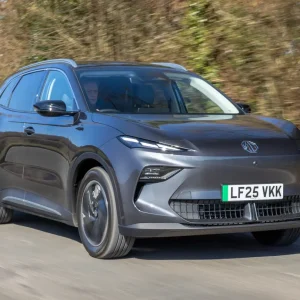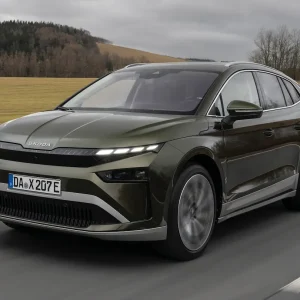The new Hyundai Kona was developed as an EV first – as we previous noted when we reviewed the Kona Electric. So, you might ask, have other powertrain options in the range been compromised? To find out, we’ve also spent time with a hybrid model.
The hybrid powertrain in question pairs a 105hp, 1.6-litre petrol engine with a 44hp electric motor, with a total system output of 141hp. That’s a bit down on the electric versions, and while the hybrid’s acceleration is still fairly punchy around town, the engine needs to be worked a bit harder to get up to motorway speeds. The hybrid powertrain comes with a six-speed DCT automatic gearbox, and this can compromise refinement – when the Sport driving mode is selected it holds onto low gears in a fairly extreme way, and this also happens to a certain degree in Eco mode (strangely there is no Normal option), where a couple of times we reached for the shift paddles to change up manually and reduce the revs, only to be disappointed as these only work with Sport mode.
Ride quality is fairly good, and the car feels best suited to relaxed cruising – there’s no undue roll in corners but it feels a bit big and ponderous, with lifeless steering and an uncommunicative brake pedal that makes it tricky to gauge how much force to apply.
Driving on narrow UK country roads, we also found the intrusive lane warning bongs annoying – and were bizarrely warned to take a break from driving when we’d only been on the go for ten minutes. We also came across an ergonomic annoyance with this reviewer’s size-11 shoe catching a metal plate on the steering column when using the brake pedal (not a problem with the electric version we drove on the international launch, on which this plate was mounted much higher – we’re not sure if this is powertrain-specific, or a right-hand-drive conversion issue).
That niggle aside, most of the impressive interior attributes from the electric version also apply here, such as the roomy interior (and spacious boot) and impressive pair of 12.3in screens. Our hybrid test car was in the sports-inspired (though purely cosmetic) N Line equipment grade, which gives you (in addition to exterior styling features such as side skirts and twin exhaust tips) some red detailing around the interior and aluminium pedals. Trim however is quite plasticky generally with this spec, with a hard finish to the driver’s door armrest a particular disappointment.
In terms of running costs, the hybrid can’t compete with the 2% BIK company car tax rate of the electric variant, but on a cost-per-mile basis it does work out cheaper thanks to its lower P11D. The Kona also comes out slightly ahead of hybrid SUV alternatives like the Honda HR-V and (unlike with the EV versions) its cousin, the Kia Niro. However, despite being more expensive, overall we’d say the Kona Electric is indeed the more convincing choice.
Hyundai Kona 1.6 Hybrid N Line
P11D: £31,595
Residual value: 52%
Depreciation: £14,970
Fuel: £6,769
Service, maintenance and repair: £2,393
Cost per mile: 40.22p
Fuel consumption: 60.1mpg
CO2 (BIK %): 106g/km (26%)
BIK 20/40% a month: £137/£274
Luggage capacity: 466 litres
Engine size/power: 1,580cc/141hp





